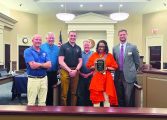Farm is pesticide, herbicide free
By Page H. Gifford
Correspondent

For farmers nowadays, considering the state of the climate is critical to their operations. Sustainability is key. Owners Dewey and Barbara Haines of Hidden Springs Family Farm in Fluvanna County recognize the problem and are pro-active when it comes to climate and growing organic. They are invested in the future of a healthy farm.
Barbara is the managing partner for Hidden Springs Family Farm. She retired from the army as a lieutenant colonel after 25 years specializing in logistics operations. Dewey serves as the infrastructure and operations manager for the farm. Dewey retired from the army as a lieutenant colonel after 26 years specializing in military police operations.
Dewey and Barbara explained how they work their farm with all their knowledge acquired from various courses and programs.
What motivated you to transition to a sustainably and regeneratively grown herbicide and pesticide-free farm?
Dewey: We didn’t transition; herbicide and pesticide free was our starting point. One of the reasons we decided to farm was because the nutritional value in the food, along with the taste, had declined significantly. Additionally, our research showed us that some of the modern pesticides and fertilizers may be leading to a rise in medical issues; so, by growing it ourselves we can control the inputs. Finally, we know that food grown closer to where it is consumed has more nutrients.
Have you encountered any challenges in maintaining a herbicide and pesticide-free farm? If so, how did you overcome them?
Dewey: Yes, in year two (2023) the amount of insects that damage our produce has significantly increased. For some of the produce we place an insect barrier high tunnel over them that helped prevent the insects from getting to the plants while they were growing. Some plants can stay under the netting the whole time such as kale and cabbage, but we must remove the netting for things like eggplant once they begin to bloom so the pollinators can get to the flowers. We spend time each morning walking through the garden looking for and removing insects that may damage the plants.
What sustainable farming practices do you employ to maintain soil health and fertility?
Dewey: Overall, we are trying to manage the farm as a whole system; understanding that each part, forest, pastures, garden, livestock, pollinator habitat, beehives, etc. benefits and relies on the other.
Barbara: In the market garden we rotate our crops annually and try not to plant the same variety within five rows of each other to reduce pest pressure. By planting similar varieties at least five rows apart we prevent the pests from jumping from one row to another. Additionally, we have an extremely diversified planting. We plant over 30 different vegetables each year. When beds are not in use, we add cover crops to help build the soil and to feed the pollinators. We also practice reduced tillage. The only time we tilled was when we initially constructed the beds (in 2022). Since then, we broad fork each bed to reduce the compaction and increase water infiltration. We use a power harrow that penetrates the top two inches of the soil to help mix in the compost we add. The market garden was built by the family, including our four children and their significant others. Each bed was built above ground, 5.5 inches of compost with woodchips from the farm and local community around each bed and as paths. The woodchips breakdown providing nutrients to the soil. Additionally, by not tilling we help to keep the soil food web intact throughout the year, benefiting the soil and the plants.
Dewey: In the pastures we have added clover and fescue to try and ensure the soil is covered year-round. We have integrated poultry into two of the five pasture which has significantly increased the fertility of those pastures. This fall we will begin cover cropping the other pastures to work on improving them and reducing less desirable weeds.
How do you conserve water and manage irrigation on your farm in this hot weather?
Barbara: The garden doesn’t use much water thanks to its design. The wood chips absorb excess water when we get rain and feed it back to the plants during time of drought. When we do need to water, we primarily use drip irrigation connected to an automatic waterer. Drip irrigation is a low-pressure watering system that delivers water straight to the root of the plants. This method effectively minimizes runoff and evaporation losses, as well as helps us mange blight on the tomatoes. We have the irrigation programmed to run in the evening to minimize loss of water through evaporation as well.
Dewey: The layer chicken’s wagon has gutters built into the roof that collects rain water and fills two 30-gal water barrels that have chicken waterers attached to them. In 2022, we only had to manually add water to the barrels three times when there wasn’t enough rain (we did pull them out three other times and clean them which required adding water).
Barbara: In the future we plan to add more rainwater collection points around the farm. For the pastures, we are working to add more organic matter to the soil so it will hold more water. We are doing this through cover cropping.
Can you tell me about your crop rotation and how it contributes to the overall sustainability of your farm?
Dewey: Our crop rotation contributes to the overall sustainability of our farm by providing a natural break in the lifecycle of the pests that target our crops. Our rotation allows the soils to recover by not planting the same family of crops successively. Also, by spacing our crops 3-5 rows apart we prevent the pests from indulging in an “all you can eat buffet.” Pests are typically crop specific, so by ensuring that specific crops don’t touch, we slow down the spread of pests and disease.
How do you handle potential crop losses due to pest or disease outbreaks while still maintaining your commitment to chemical-free farming?
Dewey: First, we try to learn what caused the crop loss and what herbicide and pesticide free, natural, actions we can take to prevent any more loss in the same or following year. Example, in 2023 we had a significant increase in June Bugs eating plants. After some research, we purchased beneficial nematodes that target the June Bug grubs during the winter. This should reduce the amount we have in 2024. Additionally, we spend time each morning in the market garden checking plants to remove insects or eggs to reduce the pest pressure.
Barbara: This also means that we explain to customers why we don’t have a larger quantity of some vegetables or why some vegetables look the way they do. For example, our early summer Bok Choi had flea beetle damage which we explained to customers and they were good with it because the herbicide and pesticide free vegetables were more important to them. Finally, we have learned to make value added items from produce that we couldn’t sell to customers. This includes salsa, jalapeno jelly, ketchup, strawberry jam, relishes, etc.
Have you noticed any improvements in soil health or crop yields with a sustainable and regenerative approach?
Barbara: We have seen improvements in the soil both in the two pastures where we have poultry and in the garden, due to our sustainable/regenerative practices.
What measures do you take to ensure the quality and safety of your produce without relying on chemical treatments?
Dewey: First and foremost, we work on building high quality soil for the plants. We believe that a strong plant will provide its own deterrent to pest and biological factors. Barbara spent hours researching which plants grow best in our area of Virginia.
How do you market and communicate the sustainability and regenerative aspects of your farm to consumers?
Dewey: Through social media (Facebook) and one-on-one conversations. When customers come to the farm or to our tent at the Fluvanna Farmers Market; we explain our overall concept. For those that want to know more we explain what we have done and are doing to regenerate the farm and how the different aspects work together to improve the farm and hopefully the area around the farm. Most of our Facebook posts describe what we are doing by giving background to help inform those that follow us.
Do you collaborate with other local farmers or organizations to share knowledge and best practices related to sustainable and regenerative farming?
Dewey: We collaborate as much as we can. White of Crick Hollow Farm helped us understand the local market and Shirefolk Farm supports other local farmers by hosting a feed drop at their farm. We hope to meet more like-minded farmers in Fluvanna so we can collaborate more.
Do you have any plans to expand or diversify your sustainable farming practices in the future?
Barbara: Yes, as we become proficient in our current enterprise, market garden, layer chickens, broiler (meat) chickens, and bees. We are looking to expand to other enterprises that compliment what we are already doing. Currently, we are attending a class on advanced home orcharding and plan to add some fruit and nut trees and bushes in the fall. We are also exploring adding sheep to help rehabilitate the pastures and provide a source of meat and dairy.
What support, if any, have you received from local communities or government agencies in your pursuit of sustainable farming?
Dewey: We worked with Thomas Jefferson Soil and Water to fence off the waterways on our farm from livestock. We receive runoff from three areas to include two from Lake Monticello. Most of this water flows into a creek that runs through a marshy area to help clean it, then into our pond and then down the creek were eventually it flows into the Rivanna River and then the James River. As such, we are working with the James River Association which planted over 300 Virginia native trees and bushes as a riparian buffer on both sides of the season creek. This will also help to clean the water before it gets to the James River while also providing wildlife habitat.
Additionally, the VA Department of Forestry has walked the forested areas with us and provided advice on how to maintain the hardwoods and the ecosystem. We have attended some classes at VSU College of Agriculture and are currently waiting for their regional representative to visit the farm.
Barbara: We also collaborate with a local restaurant, Tonic, which purchases from us when we have product that meets their needs. They have purchased our peppers, tomatoes and herbs.
How do you assess the overall success and impact of your farm’s approach to sustainable and regenerative agriculture?
Dewey: We determine the success of our policies by two metrics: the production of disease-free tasty produce without the need to add pesticides or herbicides; and the farm’s ability to pay its own expenses.
Ultimately, we will determine the success of our approach to sustainable and regenerative agriculture through the farm’s ecosystem – are the animals, plants, and microbes flourishing in conjunction with us?
One of the key ways we will evaluate this is through the production of healthy and higher nutrient produce and poultry products.
Barbara: Additionally, we continue to evaluate our soil both in the garden and in the pastures through testing and visual inspection. As the soil in the garden improves, we should have less pest pressure while in the pastures we should have less weed pressure.




